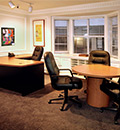Climate
Montenegro's southern areas along the coast enjoy a Mediterranean climate, having dry summers and mild, rainy winters. Central and
northern regions have Continental climate, where temperature varies greatly with elevation. Podgorica, lying near sea level in the
valley of the central region, is noted for having the warmest July temperatures in Montenegro, averaging 35-40°C (95-104 F).
Cetinje, in the Karst at an elevation of 670m (2,200 ft), has a temperature 5°C (10 F) lower. January temperatures range from 8°C
(46 F) from Bar on the southern coast to -3°C (27 F) in the northern region.
Montenegro's mountainous regions receive some of
the highest amounts of rainfall in Europe. In the northern mountains, snow is present throughout the spring.
Terrain
The terrain of Montenegro ranges from high mountains through a segment of the Karst of the western Balkan Peninsula, to a narrow
coastal plain that is only one to four miles wide. The coastal plain disappears completely in the north, where Mount Lovcen and other
ranges plunge abruptly into the inlet of the Gulf of Kotor.
Montenegro's section of the Karst lies generally at elevations of
just below 1,000m (3,000 ft) above sea level-although some areas rise to 1800m (6,000 ft). The lowest segment is in the valley of the
Zeta River, which flows at an elevation of 460m (1,500 ft).
The high mountains of Montenegro include some of the most rugged
terrain in Europe. They average more than 2,100m (7,000 ft) in elevation.
History
Montenegro was founded as a state under its present name in 15th century, continuing the tradition of the Slavic state of Duklja.
It was able to maintain its independence during the reign of the Ottoman Empire in the Balkans, as its independence was formally
acknowledged at the Congress of Berlin in 1878.
After the World War I, fighting for the Allied powers, it was absorbed into
the Kingdom of Serbs, Croats, and Slovenes, which later became the Kingdom of Yugoslavia in 1929. Montenegro was also later part
of various incarnations of Yugoslavia, until it regained its full independence from the federation of Serbia-Montenegro in the
June 2006 referendum.
Montenegro was the only subsequent republic of the former Yugoslavia that supported Serbia during the
wars of the Former Yugoslavia in the 1990s.
Regions
Montenegro is officially divided into 24 municipalities, which can be grouped into five regions:
- Bay of Kotor: This bay is considered one of the most beautiful bays of Europe, and features the UNESCO World Heritage
Sites of Perast and Kotor, as well as other typically Mediterranean towns.
- Budva Riviera: The main tourist drag with nice beaches, historic villages and wild nightlife.
- Central Montenegro: This is the heart of the country with the state capital Podgorica, the historical capital Cetinje and
the industrial center Nikšić. It is also home to natural beauty, such as Skadar Lake National Park and Lovćen National Park.
- Montenegrin South Coast: The Adriatic coast around the towns of Bar and Ulcinj, the latter one having an Albanian majority.
- North Montenegrin Mountains: This region is entirely situated within the Dinaric Alps, famous for its untouched wild nature.
A must is the Tara River Canyon in Durmitor National Park. Žabljak is Montenegro's winter sports capital.
Cities
- Herceg Novi — founded in 1382 and located in the entrance of the Bay of Kotor
- Kotor — an ancient fortified town located deep down the Boka Kotorska bay, UNESCO World Heritage Site
- Tivat - a small town in the Bay of Kotor, quickly emerging into a major touristic, business and transport centre
- Podgorica — the capital and biggest city in Montenegro, experiencing a huge architectural boom in the last couple of years
- Budva — most popular town known for its beautiful beaches and vibrant nightlife
- Cetinje — the old royal capital of Montenegro, with a large number of museums, monasteries and former embassies
- Nikšić — the second largest city in Montenegro and economically important
- Perast — beautiful small village, a UNESCO World Natural and Historical Heritage Site
- Bečići — with a 2km long fine sandy beach, it is home to numerous resorts and hotels
- Žabljak — center of Montenegrin mountain tourism and a popular spot for skiers
Other destinations
- Biogradska Gora National Park — one of the last remaining untouched forests in Europe
- Durmitor National Park — rafting through the Tara Canyon, the deepest canyon in Europe, is one of the most popular activities in Montenegro
- Lovćen National Park — beautiful mountain with natural, cultural and historical scenery
- Ostrog monastery — the amazing monastery situated on the almost vertical cliff of Mount Ostrog
- Skadar Lake National Park — the largest lake on the Balkans and the natural habitat of the very diverse flora and fauna
- Sveti Stefan — picturesque town-hotel, a former fishermen town on the small peninsula near Budva (currently closed for renovation)
See
Montenegro may be small in terms of area, but it boasts stunning mountainous landscapes, dramatic coast lines, historic monuments and
truly beautiful walled towns. The Montenegro coast is just as gorgeous as that of its better known neighbour, Croatia, and it is for
good reason that its main tourist destinations can get crowded in summer. Nevertheless, if you can't visit at another time, don't let
their popularity hold you back. Even the largest of cruise ship crowds will not stop you from enjoying this country's magnificent Riviera
and Medieval coast towns, especially if you're willing to get up early and do your sightseeing ahead of the others.
Of the country's many churches and monasteries, the Serbian Orthodox Monastery of Ostrog deserves special attention. It's spectacularly
located against a practically vertical background, some 15 km from Nikšić. Founded in the 17th century, it's one of the most visited
pilgrimage destinations on the Balkans and boasts a magnificent view over the Bjelopavlići plain.
The Riviera
The Bay of Kotor is probably one of the prettiest bays in the world. On its deepest point lies the equally stunning town of Kotor, a
beautifully preserved fortified, Medieval town with a vibrant history. Wandering through its labyrinth of narrow and cobblestoned streets,
you'll come across lively piazzas, many ancient churches and lots of pleasant bars and restaurants. Don't miss the 12th century St. Tryphon
Cathedral, the Church of St. Luke and the Orthodox St Nicholas Church. Kotor is locked between the blue sea on one side, and a dramatically
steep cliff on the other. It's a heavy walk uphill, but climbing the 1500 steps will allow you to see the old fortifications on the top as
well as provide some amazing views over the bay.
Budva is the country's most popular tourist destination and boast some great beaches as well as a lovely, walled town centre. The old town
centre is picturesquely located on a rather small peninsula, and its narrow, winding lanes hide a multitude of historic buildings, churches
and small squares. Among the most interesting monuments here are the 7th century St. John's Church, the 8th century Santa Marija of Punta
and the 12th century Church of St. Sava. The medieval town fortress is referred to as Citadela and right next to it is the colourful Church
of the Holy Trinity, built in 1804. Budva's over 30 km long Riviera has been called "The Riviera of Sandy Beaches" and is dotted with lovely
hamlets and a wealth of historic monuments. A strip of hotels and restaurants separates it from the impressive mountain massifs of Lovcen.
From Budva, it's an easy bus ride to the unique Sveti Stefan resort.
The small but gorgeous town of Perast saw some of its best architecture arise in the 17th and 18th century, when it belonged to the Republic
of Venice. That typically Venetian, baroque architecture has been wonderfully preserved, with highlights including the Bujovic, Zmajevic,
Badovic and Smekja Palaces which were once owned by wealthy maritime captains. All the way in the south, Ulcinj is one of the Adriatic's
oldest towns, with a delightful centre and lots of natural beauty around. It also makes a good base from where to explore the old centre of
nearby Bar, Lake Skadar or even a cross border visit to Albania. Although less spectacular than nearby Kotor, Herceg Novi (roughly translated
as New Castle) is another charming Montenegrin town with a beautiful old centre and a good number of interesting churches, squares and fortresses.
Natural attractions
Although Montenegro's magnificent sea side scenery is best known among travellers, its mountainous inland has some grand panoramic views to
offer, too. The country shares the large freshwater Lake Skadar with neighbouring Albania. It has National Park status and offers great
opportunities for hiking, bird watching and wildlife spotting. Of the many friendly fishermen's towns around it, Virpazar is the most
convenient one for travellers. A real must-see is the splendid Tara River Canyon, with its steep banks rising up to 1300 meters above the
River Tara waters. It's the second longest canyon in the world and a UNESCO World Heritage Site. The canyon is located in Durmitor National
Park, which is a World Heritage Site of its own and boasts a rich flora and fauna as well as snow-covered high peaks, several canyons and
many glacier lakes. The most visited one is Black Lake, at walking distance of the town of Žabljak, which serves as a traveller's hub for
mountain and winter tourism.
Do
Montenegro has really developed as an 'Adventure Tourism' destination in recent years. A number of companies have invested in training
and equipment to provide: White Water Rafting (along Europe's deepest canyon), Kayaking, Mountain Biking, Climbing, Scuba, Sailing, Wind
and Kitesurfing, Horse Riding, Hiking and Paragliding.
Montenegro makes a fantastic location for all Mountain activities, much of the interior is uninhabited mountain and forest wilderness,
with dramatic scenery and some of Europe's last bears, wolves and occasionally lynx. Diving is also very attractive; Montenegro may not
have the underwater coral gardens of Sharm El Sheik, but there are quite a few semi-exotic species, incredible visibility, impressive
underwater topography and a profusion of diveable historic wrecks (7 in the Bay of Kotor alone).
Eat
Apart from the hotels located in towns and summer resorts offering half-board and full-board accommodation, and those along the roads and
communication lines such as restaurants, pizza places, taverns, fast food restaurants and cafes, there is a choice of national restaurants
offering traditional Montenegrin cuisine.
In addition to the standard European and Mediterranean cuisine, Montenegro offers a variety of healthy food products and local specialities.
Cold hors-d'oeuvres include the famous njeguški pršut (smoked ham) and njeguški cheese, pljevaljski cheese, mushrooms, donuts and dried bleak.
The main courses specific for the northern mountainous region are boiled lamb, lamb cooked in milk, cicvara in fresh milk cream (buttered corn
porridge), boiled potatoes with cheese and fresh cream. A selection of traditional recipes of the central and coastal parts will include the
kastradina (dried mutton), smoked and fresh carp (from Skadar lake) and a variety of fresh sea fish and seafood dishes. Donuts served with
honey and dried figs are traditional desserts in these parts of Montenegro.
Drink
Wine
The legal purchasing age of alcoholic beverages is 18, but there is no legal age for drinking.
Montenegrin vineyards and the production
of quality wine is part of the tradition of southern and coastal wine makers.
The best known Montenegrin wines are the premium whites:
"Krstač", "CaDavoset", "Chardonnay" and reds: "Vranac", "Pro Corde". All of them are produced by the famous company "Plantaže", but there's
also some home-made wines of high quality, like Crmničko wine.
1L bottle of "Vranac" red wine will cost you from €8 to €15 in the bar
or restaurant and it is well worth it! Also, you can buy a bottle of "Plantaze"'s wine for about €2-€4 in supermarkets.
Brandy
The continental region and north are more oriented towards the production of aromatic fruit flavoured brandy (plum brandy - šljivovica,
apple brandy - jabukovača). Grape brandy "Montenegrin loza", "Prvijenac", "Kruna" or home made grape brandy (lozova rakija, lozovača) is
a must-try, and a good choice to "warm up" before going out in the evening.
Beer
"Nikšićko" beer is the best known beer in the Montenegro, and most common alcoholic beverage, which cost from €0.50 to €2.50. It is produced
as a draught beer, or bottled, in both "Nik Gold" and lighter "Nik Cool" variant. The dark variant, "Nik tamno", is praised among beer lovers.
The local word for beer is 'pivo', strangely Montenegro also has a river called Piva.
Other
Other alcoholic drinks can cost anywhere between €1 and €10.
Stay safe
Montenegro is generally a safe country. There is, like all countries in the world, a number of criminal activities, but police forces are
generally fast in their duties. The number is 122, as well as the international distress call 112. Organized crime is regarded as being
widespread, but doesn't target tourists. When travelling in the areas bordering Kosovo, it is recommended you keep to the main roads.
Unexploded landmines may remain along the Kosovo border. You should also avoid areas where there is military activity.
In the resort towns such as Kotor, Budva, Sveti Stefan and Herceg Novi, beggars and pickpockets are not uncommon. As in many other European
locations, beggars are part of organized crime groups. Do not give them money. Doing so may also make you a target for more aggressive
approaches. Always carry your bags in the safest way, slung around your shoulder with the pouch in front (with your money carried under
your clothing) where you can keep your arm or hand across it.
Respect
Montenegrins are generally, like most people in the Balkans, very hospitable and welcoming to visitors.
Short pants are usually not permitted inside the public institutions (hospitals, etc). Wear modest dress when visiting monasteries and
churches.
At beaches, taking off the bottom piece of a swimsuit will likely create a stir, and is generally reserved for designated nude beaches.
Being visibly drunk is a sign of bad taste and character in Montenegro: You may be invited to drink gallons, but are expected to be able
to hold your drink. People also usually prefer to sip their liquor instead of emptying it in "bottoms-up" style. Be careful, "rakija", a
plum spirit (usually about 53% alcohol content), is stronger than expected, and will make you drunk fast!








